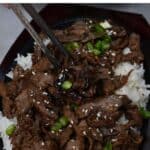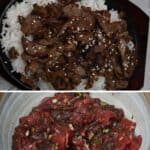This post may contain affiliate links. Please read our disclosure policy.
Make restaurant-quality, traditional Korean beef bulgogi (Korean BBQ beef) at home in under an hour (including the marinating time!) – melt-in-the-mouth tender, juicy, delicious thin beef strips!
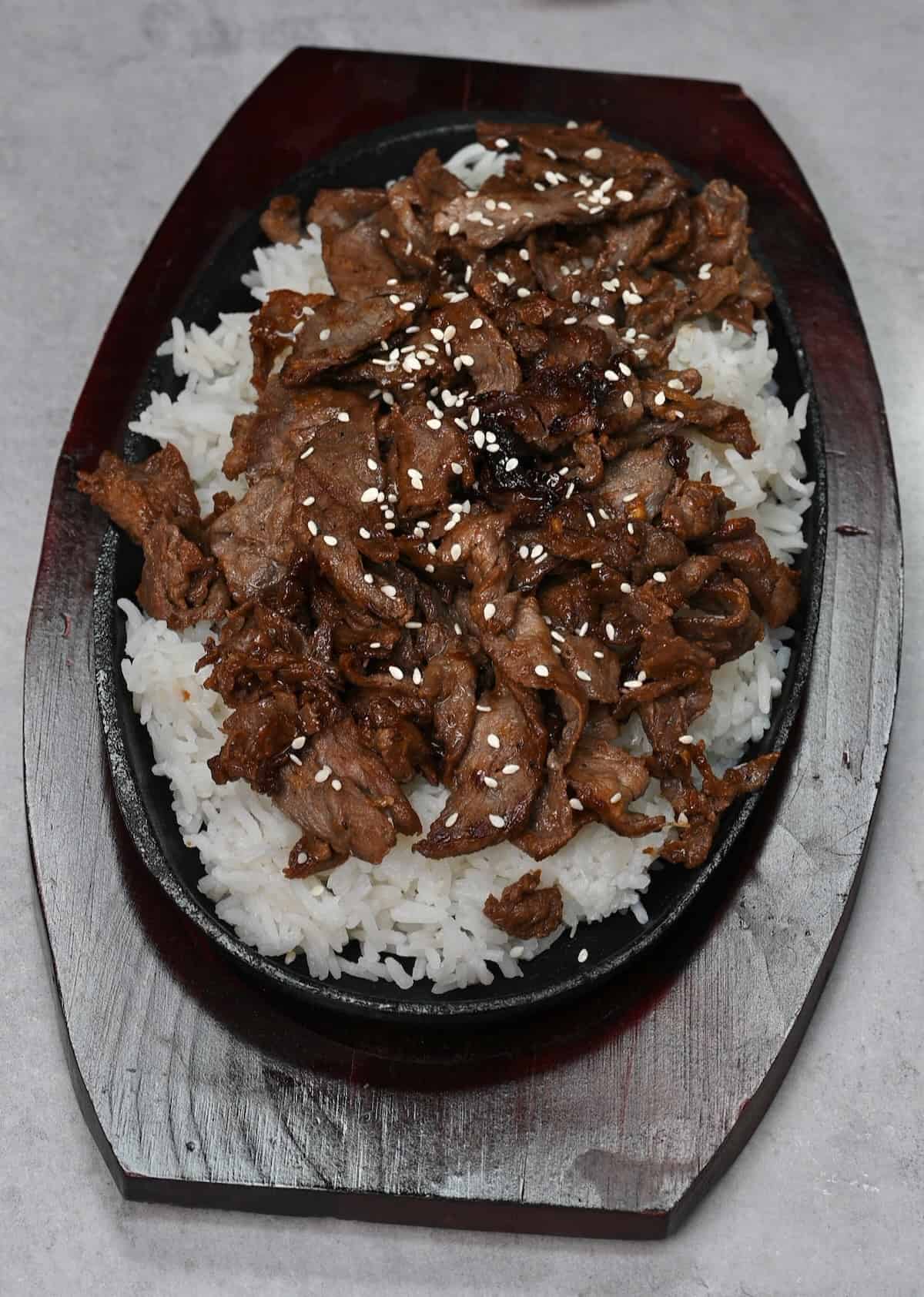
Beef bulgogi (bool-goh-gee, aka “fire meat”, also called Korean BBQ beef) is the ultimate Korean barbecue beef dish. It’s loaded with tender, succulent, thinly sliced beef marinated in a flavor-packed marinade, then stir-fried/grilled over high heat until perfectly tender, juicy, and lightly charred.
Many Korean restaurants have grills fitted in the center of the tables for customers to cook bulgogi themselves. However, it’s just as fun to prepare at home and tastes just as good! Just freeze the meat for 30 minutes, slice it up nice and THIN, marinate it in the sweet-tangy-garlicky-savory marinade for as little as 30 minutes (even better a few hours), then chuck it onto a sizzling hot pan/griddle/grill to cook in minutes.
Not only will the smell have the entire household’s mouths watering, but the taste of this BBQ beef is sweet, savory, a little smoky, and just a little charred. It’s perfect for impressing friends and family alongside rice, lettuce, BBQ chicken, and/or Korean banchan.
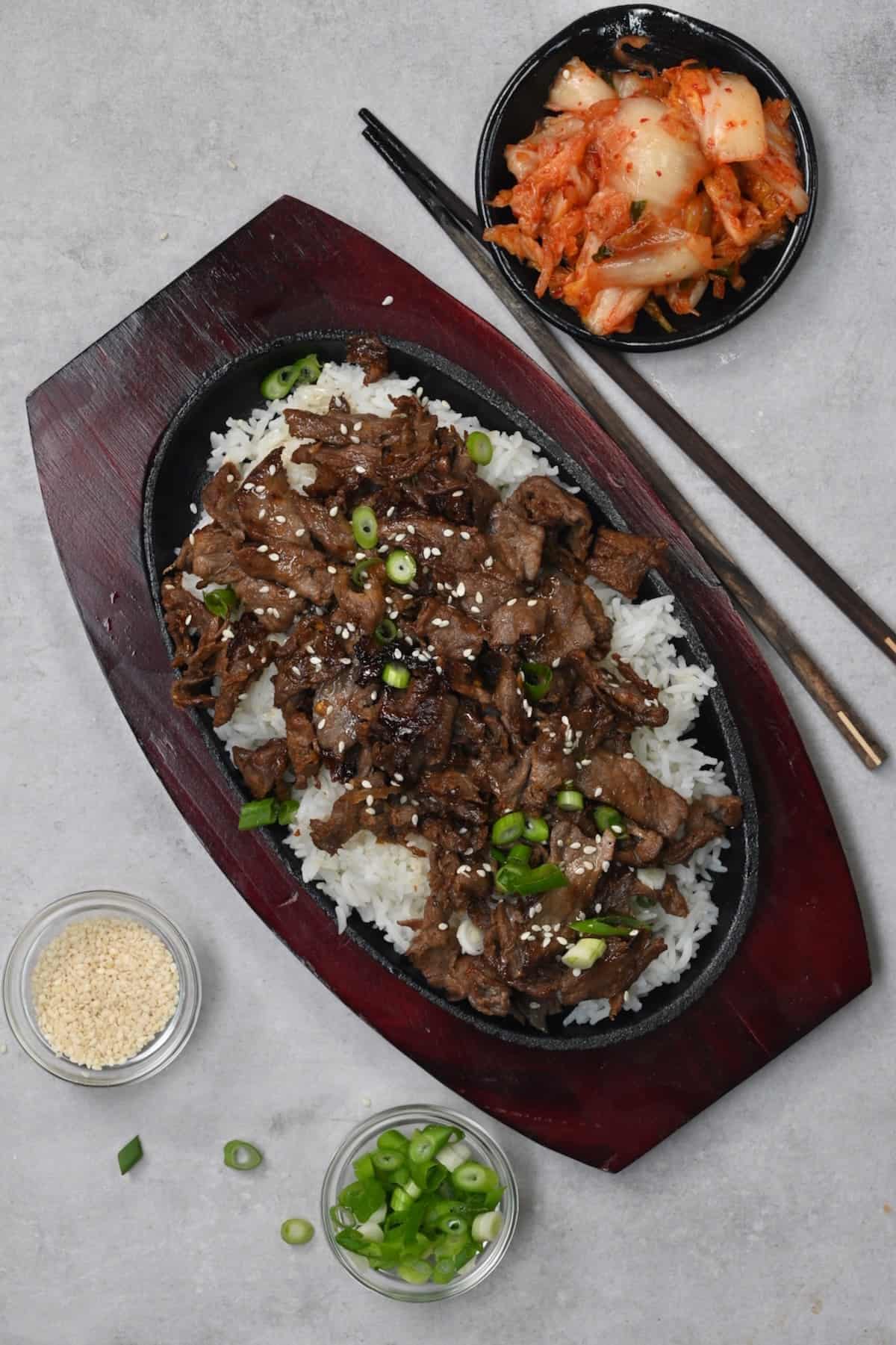
Want to save this recipe?
The ingredients
- Beef: Read below for the best cuts. To save time, purchase pre-sliced “bulgogi meat” from an Asian grocery store or ask your local butcher to pre-slice it.
- Vegetable Oil: To cook the marinated sliced beef. Canola oil would also work.
- Sesame seeds: Raw/lightly toasted sesame seeds make a perfect garnish for Korean-style BBQ beef.
Bulgogi Marinade Ingredients
- Soy sauce: Use Korean soy sauce if you can. Otherwise, use a blend of soy sauce (dark and light) for the best sauce flavor, low-sodium soy sauce if preferred, OR tamari/coconut aminos if you’re gluten-free. This adds umami-packed savoriness.
- Brown sugar: Or honey, but you’ll need less as it’s sweeter. This encourages caramelization while adding a wonderfully balanced sweetness to the marinade.
- Rice wine vinegar: Or mirin – for a slightly sweet tang and brightness.
- Toasted sesame oil: For toasty depth.
- Aromatics: You’ll need ginger and garlic for a flavorful, aromatic base.
- Kiwi: Pureed or use coarsely grated Asian pear, pineapple, a sweet apple, and/or onion. This might seem odd, but these ingredients contain enzymes that help tenderize the beef while adding a subtle sweetness.
- Black pepper: For a subtle spicy flavor.
- Green onion: For a burst of freshness.
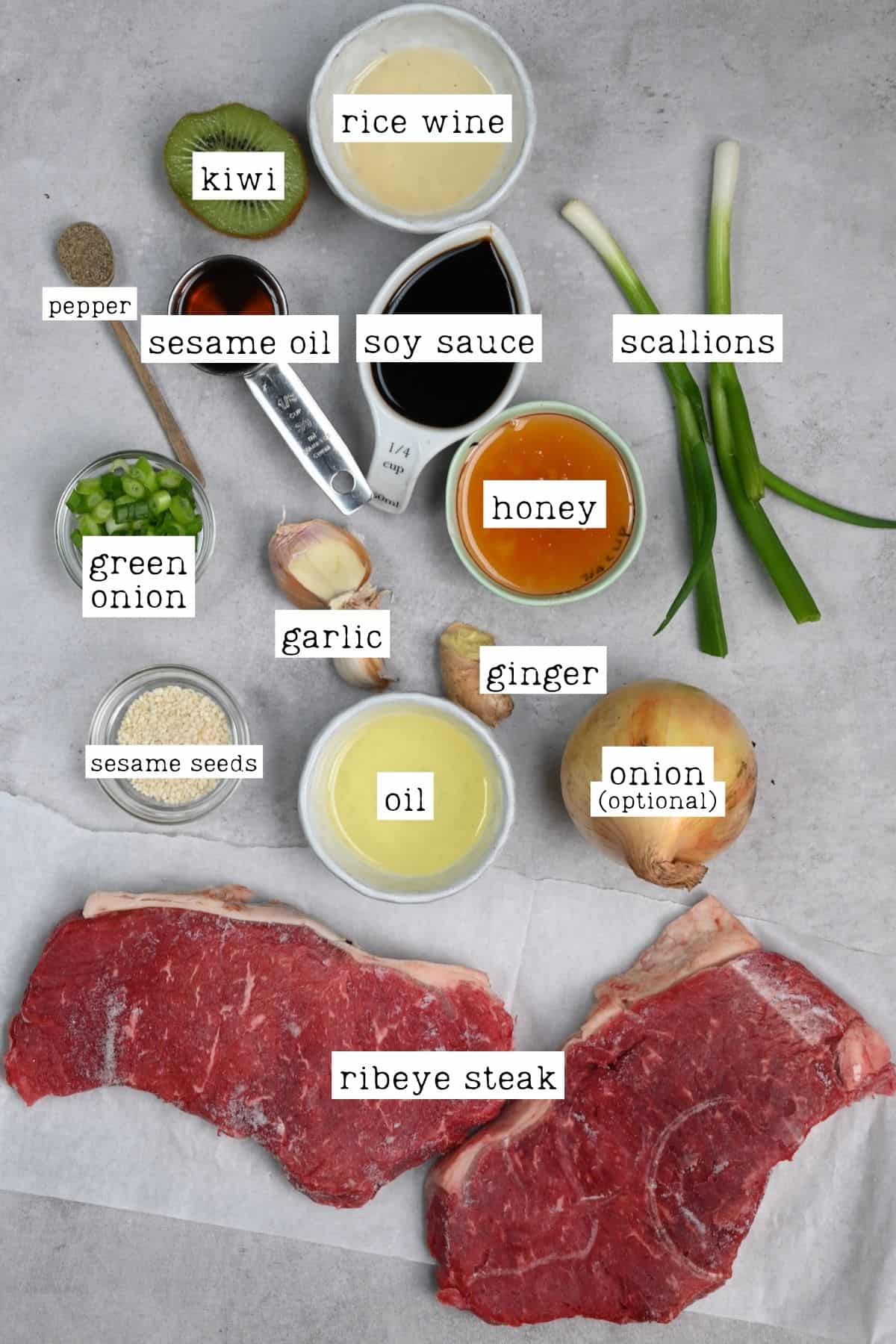
To add some spice to the bulgogi marinade recipe, add a small amount of Korean red pepper paste (gochujang) – about 2-3 teaspoons, or a pinch of Korean red pepper flakes.
What are The Best Beef Cuts for Beef Bulgogi?
Similar to beef stir-fries, the best cuts of beef for this Korean bulgogi recipe are super tender and highly suited to quick cooking methods:
- Ribeye: This is the classic and traditional beef cut, as it’s tender and well-marbled, meaning it cooks quickly with great flavor and texture.
- Sirloin: Top sirloin (or center-cut sirloin) are also tender cuts with a nice beefy flavor.
- Other: You can also use other typical stir-fry cuts that aren’t as tender but are well marbled/will be tender when sliced thinly against the grain. I.e., flank steak, flat iron (top blade), skirt steak, hanger steak, tenderloin, or brisket.
Did you know this same marinade and method also works with chicken, pork, tofu, and shrimp?! Simply adjust the cooking times as needed. You could also use ground beef – brown it, drain it, then add the marinade as a sauce.
How to make Korean beef Bulgogi
First, wrap the meat in plastic wrap and transfer it to the freezer for 30 minutes (up to 2 hours). This makes it easier to cut into very thin pieces.
Prepare the Marinade
Meanwhile, as the beef freezes, mince/grate the ginger and garlic, finely slice the green onion, mash the kiwi (or Asian pear) into a puree, and combine them with the remaining marinade ingredients in a large bowl.
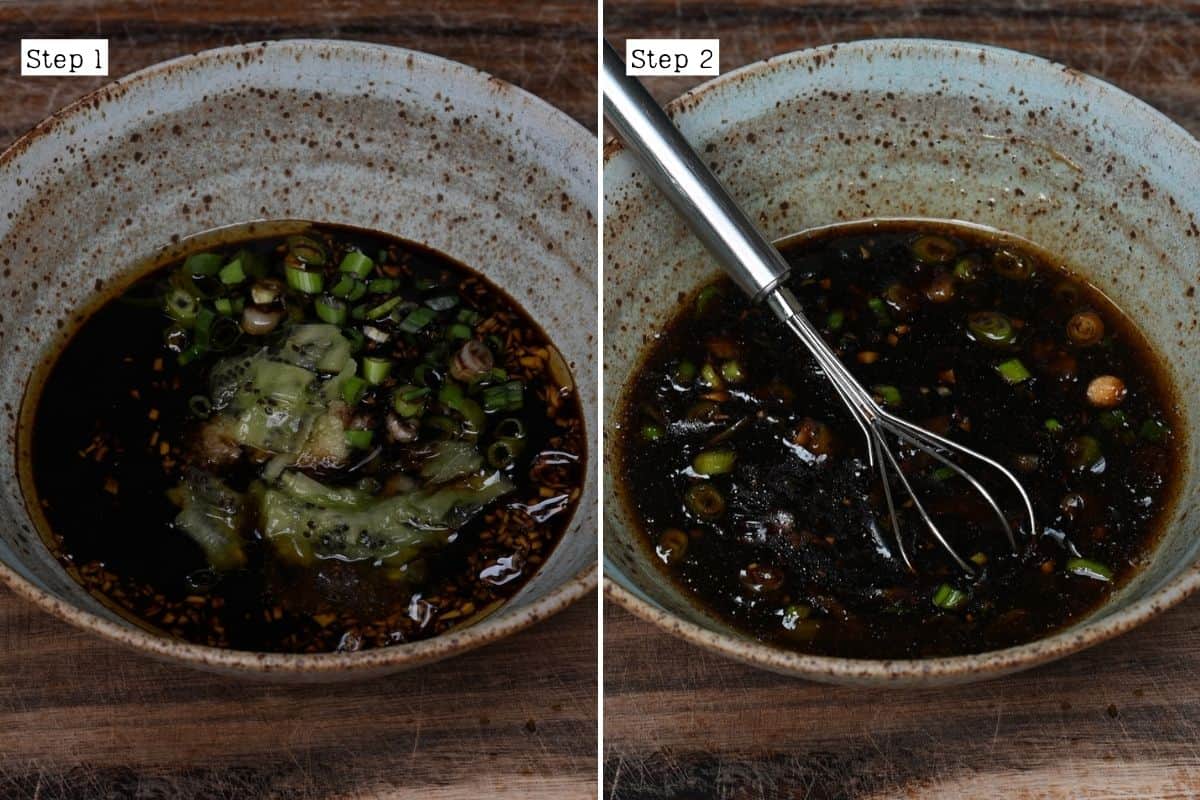
Alternatively, chuck everything in a blender and blend until smooth.
Thinly Slice the Beef
Use a sharp knife/mandoline to carefully cut very thin slices against the grain of the meat. The ideal thickness for beef bulgogi is between 1/4 to 1/8 inch (3-6 mm). It’s important to cut it evenly so they cook evenly.
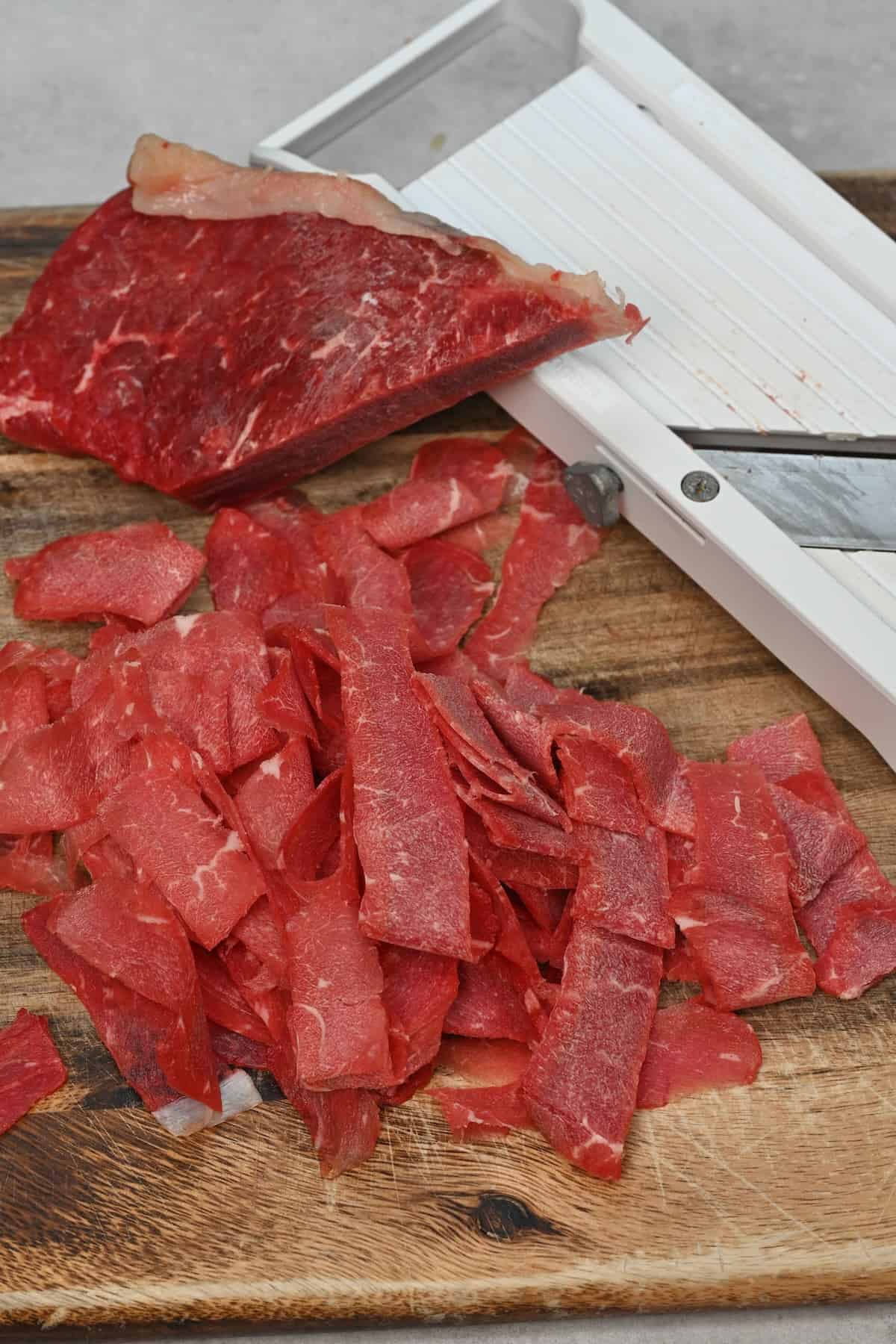
It’s important to slice against the grain – this means perpendicular to the direction of the muscle fibers, cutting through the muscle fibers for a more tender bite.
Marinate the Beef
Transfer the thinly sliced beef to the marinade bowl and mix well, gently massaging it into the meat with your hands.
Then cover the bowl and leave it to marinate in the refrigerator for at least 30 minutes (up to overnight).
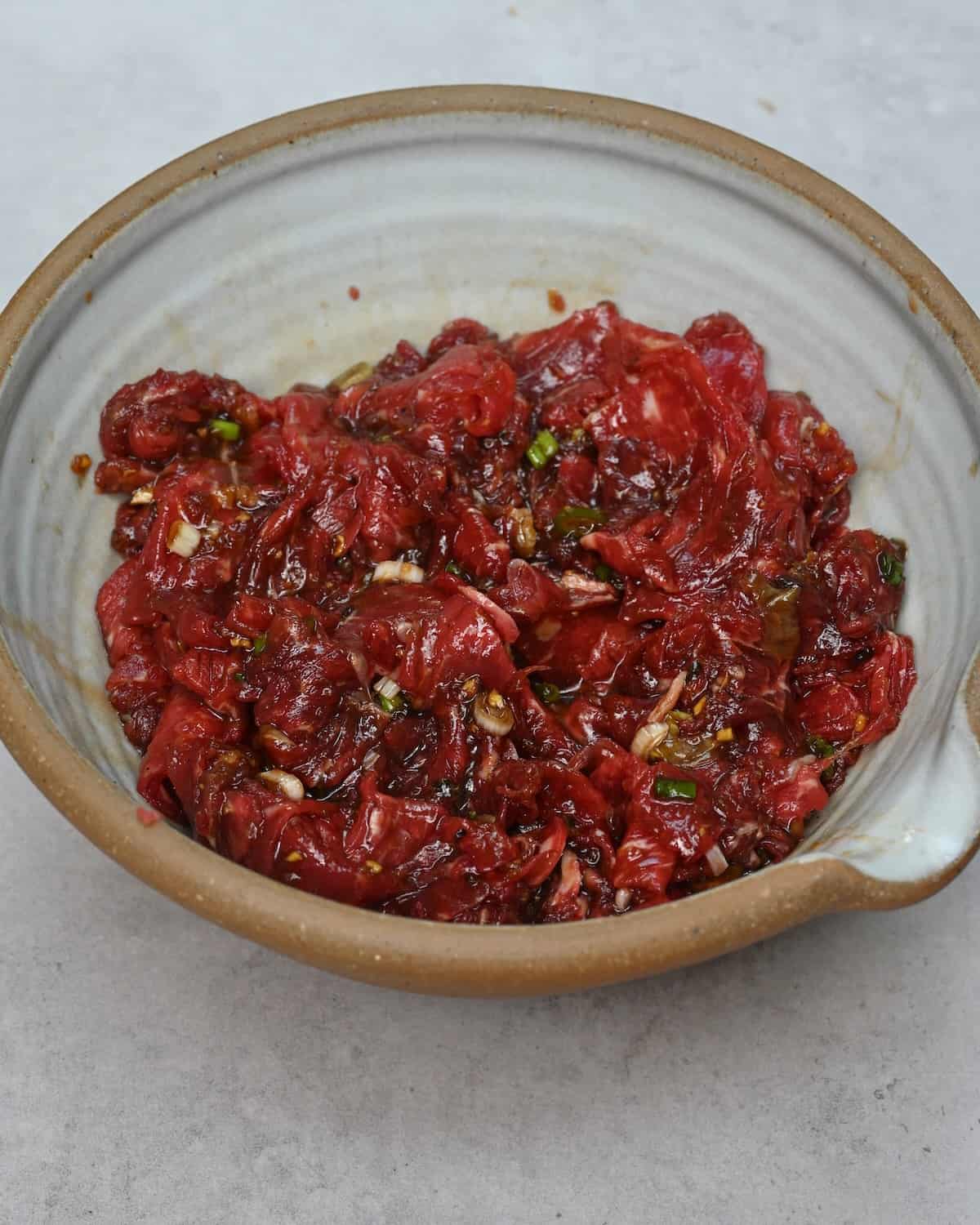
Grill the Marinated Bulgogi
Heat a large griddle pan/skillet (a cast-iron pan or grill pan will work best) or BBQ grill over medium-high heat and brush it with vegetable oil.
Once the vegetable oil is shimmering, use tongs to add the beef in a single layer (shake off excess marinade first).
Cook it for a few minutes per side (between 2-4 minutes based on its thickness and the cooking method – a grill will take the least).
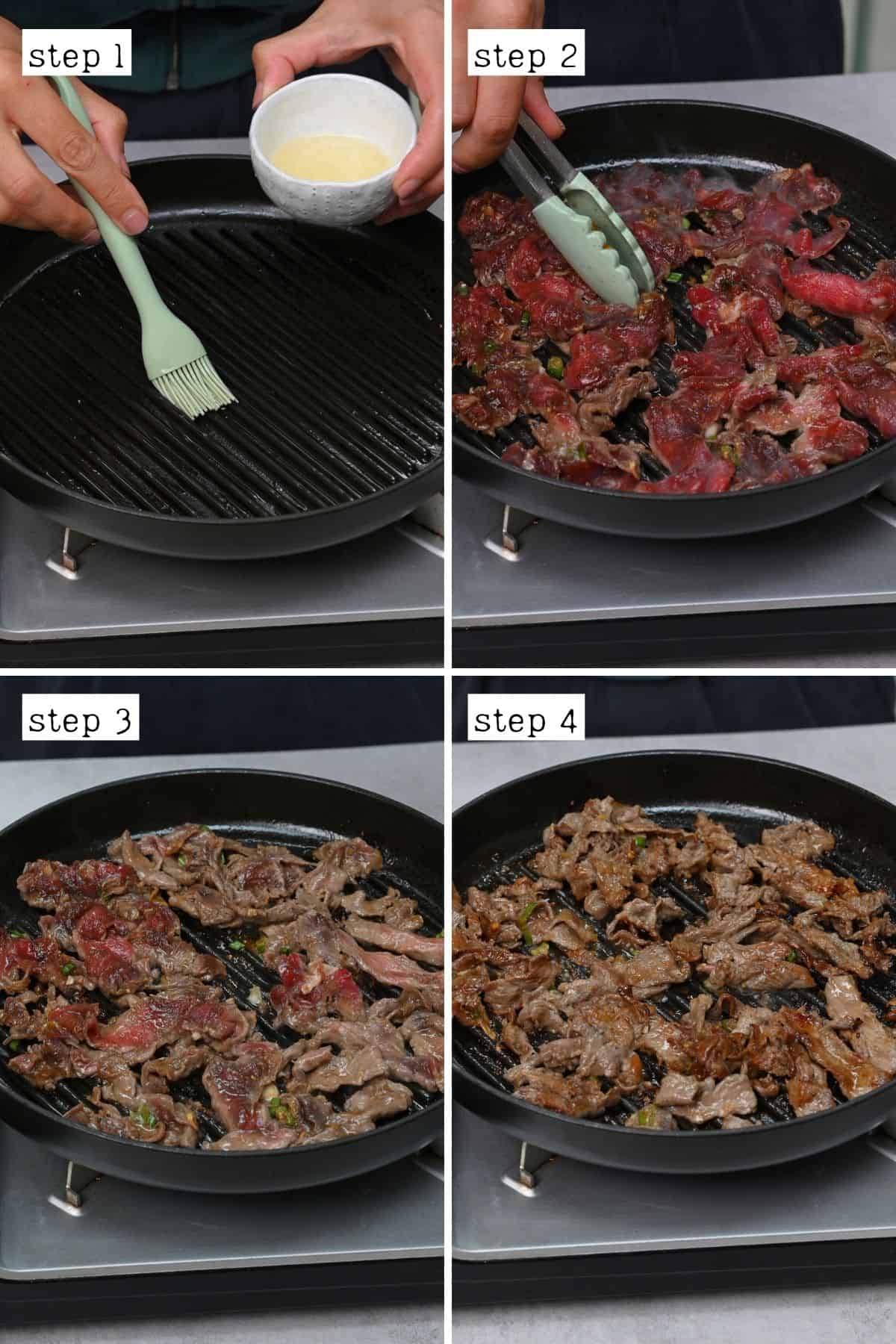
Serve the beef optionally garnished with sesame seeds, and enjoy!
What to serve with Korean beef Bulgogi
This easy beef recipe is a Korean barbecue favorite and pairs wonderfully with:
- Dipping sauce: I.e., ssamjang, gochujang, or this simple dumpling sauce.
- Banchan: (aka Korean side dishes) like kimchi (or other pickled vegetables like cucumber, carrot, or pickled daikon radish), potato salad, cucumber salad, bean sprout salad, tteokbokki (spicy rice cakes), etc.
- Other vegetables: i.e., broccoli, bok choy, asparagus, green beans, etc.
- Rice or noodles: i.e., steamed white rice, jasmine rice, brown rice, or glass/rice noodles, etc.
- Lettuce wraps: Wrap the bulgogi in super crisp lettuce leaves (like red leaf lettuce or perilla leaves), optionally with a little rice and/or kimchi, green onions, and gochujang or ssamjang (a Korean BBQ dipping sauce).
- Seaweed wraps: Wrap the bulgogi (and rice) in roasted seaweed sheets (gim/nori).
- Bibimbap: Create a delicious bulgogi bibimbap bowl with rice, kimchi, veggies (like avocado, carrots, cabbage, etc.), sauce, and, optionally, a runny egg (fried or boiled).
- Pajeon: (Scallion/veg pancakes) are a simple and delicious hearty side to the bulgogi.
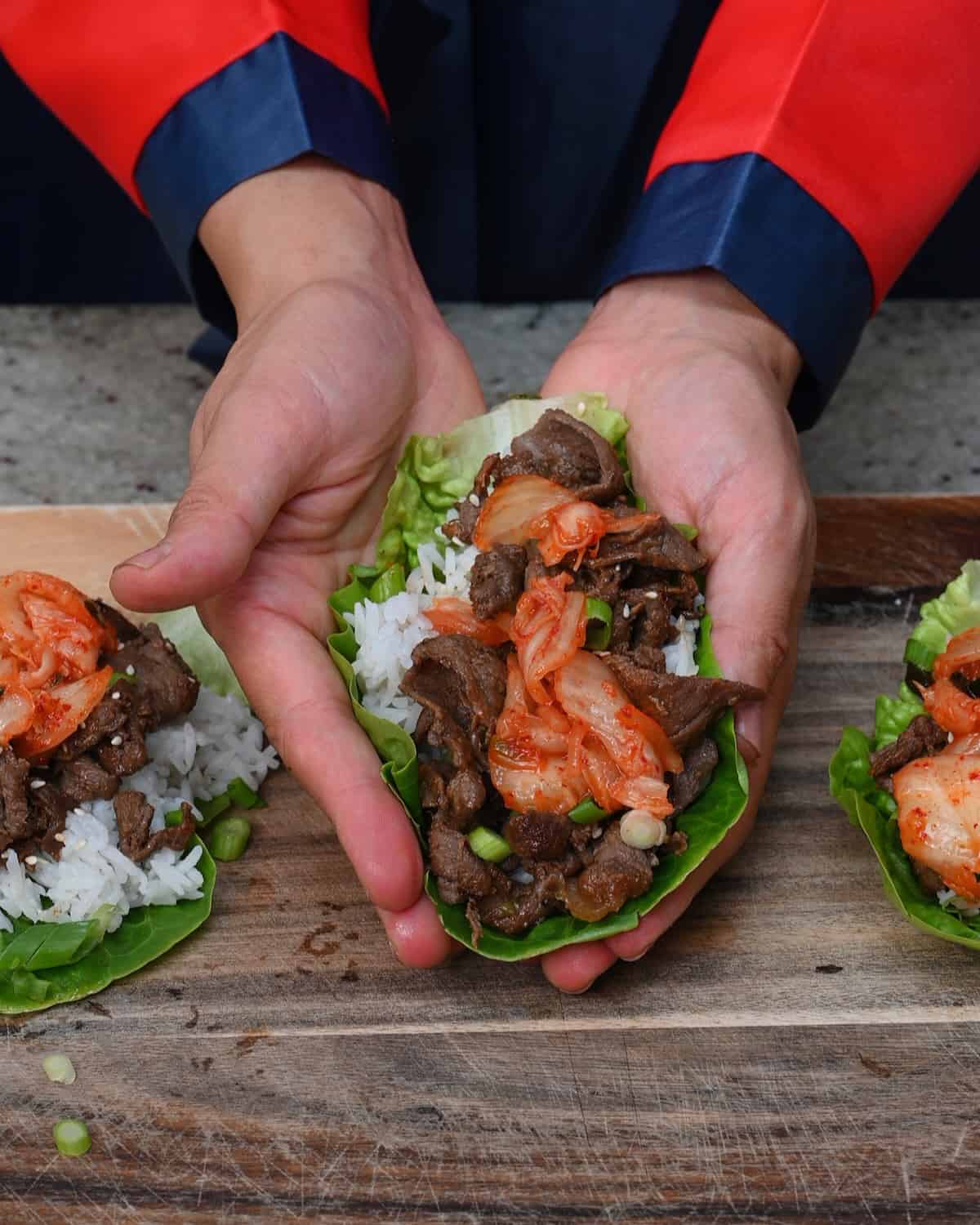
You can also use the leftovers in wraps or tacos, over pizza, in spring rolls, etc.
Tips for recipe success
- Use the best beef: Use tender beef cuts that contain plenty of marbling.
- Slice the beef into thin strips: Between 1/4-1/8 inch is ideal. To make this easier, partially freeze the meat for 30-120 minutes, use a SHARP knife, and slice against the grain to ensure tenderness. Using a mandoline will help make this quick and easy. To save time, ask your butcher to slice it or buy pre-sliced beef.
- Add a tenderizing fruit: Traditionally, Korean pear is used, but you can choose from several ingredients that contain enzymes to make the beef tender. Note that kiwi and pineapple are the strongest tenderizers, so use them sparingly and marinate for a maximum of 3-4 hours (others can be left overnight).
- Use a HOT skillet: It needs to sizzle as soon as it touches the pan to develop that delicious sear and seal in the juices.
- Don’t overcrowd the pan: The thinly sliced meat must be cooked in a single layer, so do so in batches if necessary. Otherwise, it won’t sear properly or cook evenly.
- Grilling vs. pan-frying: The results will differ slightly depending on your cooking method. I.e., grilling and a cast-iron pan will provide the best charr and smokiness compared to regular skillet pan-frying, which can be more “juicy.”
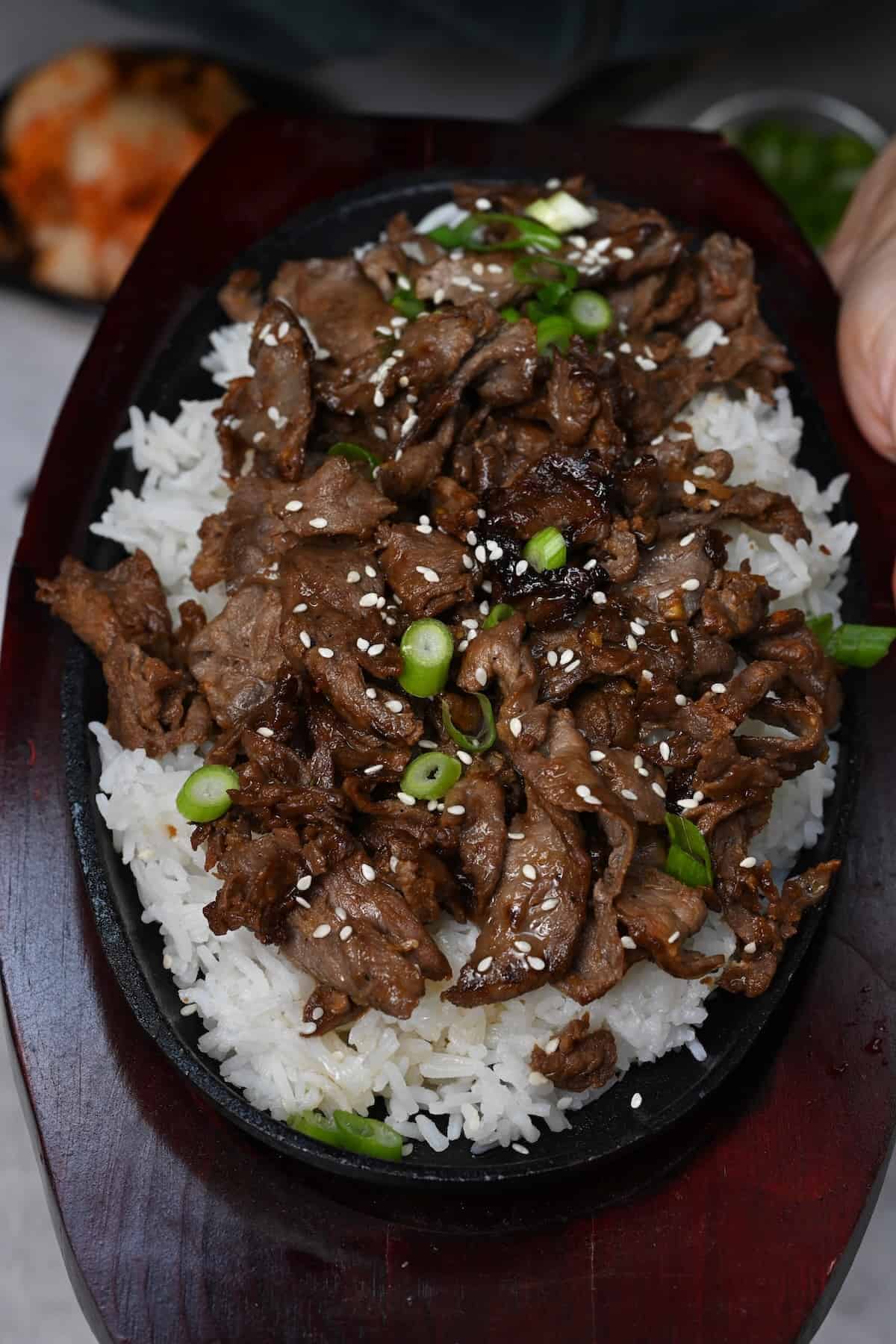
More beef recipes
- Beef birria tacos
- Crockpot beef brisket
- Oven-baked beef short ribs
- Easy beef stir fry
- Easy Mongolian Beef
If you try this easy Korean beef, let me know how it goes in the comments below. I’d appreciate a recipe card rating and would love to see your recipe recreations – tag me on Instagram @Alphafoodie!
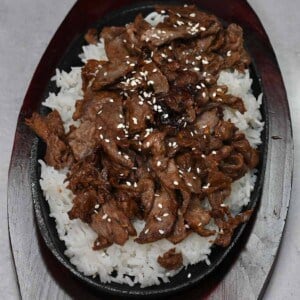
Korean Beef Bulgogi (Korean BBQ Beef)
Ingredients
- 1 lb ribeye steak or sirloin; flank steak, flat iron, skirt steak, hanger, or tenderloin would also work
- 2 Tbsp vegetable oil or canola oil
- 1 Tbsp sesame seeds for garnish, raw or lightly toasted; adjust to taste
Marinade
- 1/4 cup soy sauce use Korean or a blend of Japanese dark and light; use tamari or coconut aminos if gluten-free
- 1/4 cup honey or brown sugar
- 2 Tbsp rice wine vinegar or mirin
- 2 Tbsp sesame oil
- 2 Tbsp minced garlic from 3 large cloves
- 1/2 Tbsp minced ginger
- 1 stalk green onion
- 1/4 tsp black pepper
- 1/2 kiwi 1 Tbsp pureed; OR 2 Tbsp pureed Asian pear pureed OR 3 Tbsp onion puree
Instructions
- Wrap the meat in plastic wrap and transfer it to the freezer for 30 minutes (up to 2 hours). This makes it easier to cut into very thin pieces.
Prepare the Marinade
- Meanwhile, as the beef freezes, mince/grate the ginger and garlic, finely slice the green onion, and mash the kiwi (or Asian pear) into a puree.
- Combine them with the remaining marinade ingredients in a large bowl.Alternatively, chuck everything in a blender and blend until smooth.
Thinly Slice the Beef
- Use a sharp knife/mandoline to carefully slice very thin slices against the grain of the meat. The ideal thickness for beef bulgogi is between 1/4- to 1/8 inch (3-6 mm), with the latter being easiest with a mandoline. It's important to cut it evenly so they cook evenly.It's important to slice against the grain – this means perpendicular to the direction of the muscle fibers, cutting through the muscle fibers for a more tender bite.
Marinate the Beef
- Transfer the thinly sliced beef to the marinade bowl and mix well, gently massaging it into the meat with your hands.
- Cover the bowl and leave it to marinate in the refrigerator for at least 30 minutes (up to overnight).
Grill the Marinated Bulgogi
- Heat a large griddle pan/skillet (a cast-iron pan or grill pan will work best) or BBQ grill over medium-high heat and brush it with vegetable oil.
- Once the vegetable oil is shimmering, use tongs to add the beef in a single layer (shake off excess marinade first).Cook it for a few minutes per side (between 2-4 minutes based on its thickness and the cooking method – a grill will take the least).
- Serve the Korean-style BBQ beef optionally garnished with sesame seeds, and enjoy!
Video
Notes
Nutrition
Nutrition information is automatically calculated, so should only be used as an approximation.

